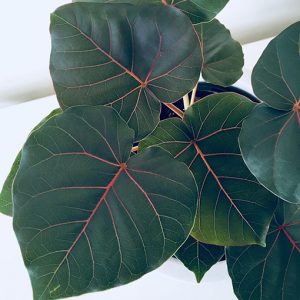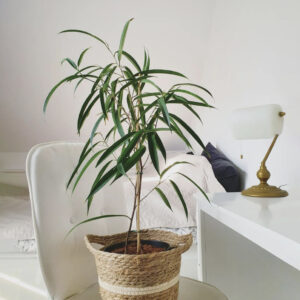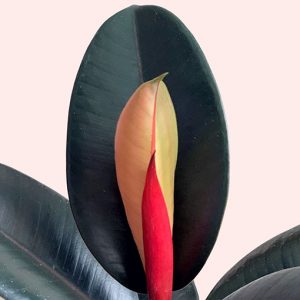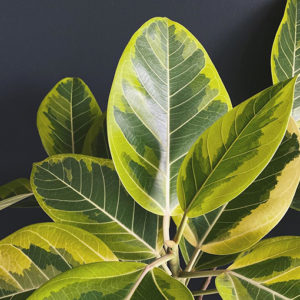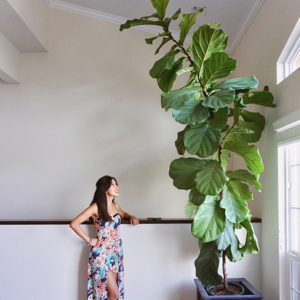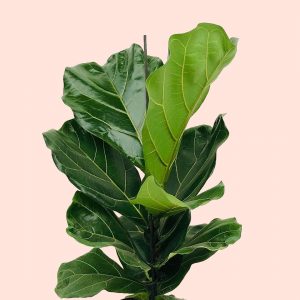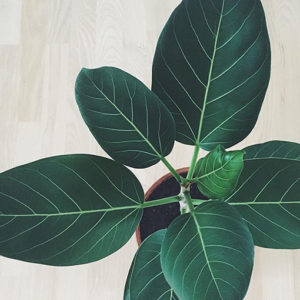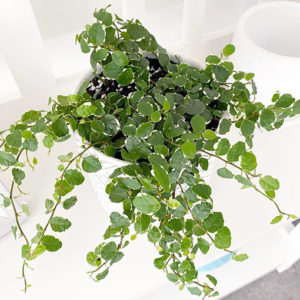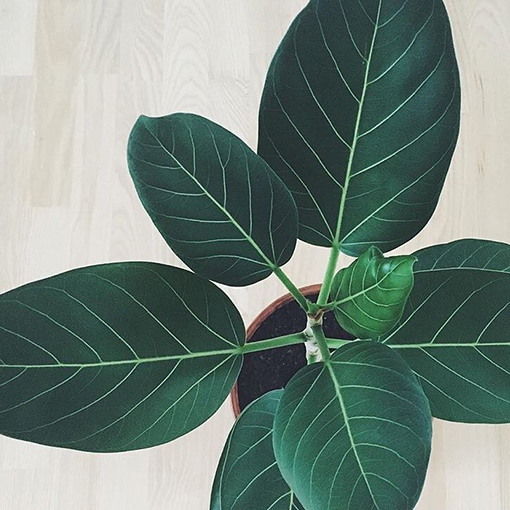
How stunning are these guys? Introducing Ficus Benghalensis Audrey and their velvety, white vein popping, jungle green leafy goodness! We’re Super excited to have a small bunch!! Cannot wait but you better get in quick! 😍💃 🌿
📷: @plantseyefind
Why we’re glad you asked as we do our best to have a relatively steady supply of Ficus Pumila Ice Caps. Click here to See if we have any Ficus Audrey in Stock!
Ficus Audrey Introduction
The Ficus Audrey has become a popular indoor plant for its nice, friendly, velvety, green, oblong, foliage with classical leaf veins and tree like growth habit. It is a good alternative to the more common Fiddle Leaf Figs and Rubber Trees and its smaller leaves create an airiness, which can be manicured and sculptured to be a Standard (ball of foliage at the top) or allowed to grow into a more organic form. Native to the Indian subcontinent, Ficus Audrey in its natural habitat enjoys wide and extensive spreading out of both branches and roots. Commonly known by names; Banyan, Banyan fig and Indian Banyan, Ficus Audrey is a common tree in the lanes of India. In the natural wild habitats, the roots of Indian Banyan travel miles beneath the soil wherever they sense moisture. A potted Banyan can grow as tall as 10 feet.
Indian Banyan exhibits large and shiny, green leaves that are oval in shape with slightly wavy margins with smooth and light-colored stem. Even a small cut can bleed your Ficus Audrey, excreting a white sticky latex which is toxic to pests. The flowers produced are small and insignificant while fruits resemble miniature Figs.
Starting out its life as an epiphyte, a young Ficus Audrey grows on another tree’s branch. The former starts growing aerial roots that are sent down to the ground, which quickly forms roots. Hence Indian Banyan is also known as the Strangler Fig.
Ficus Audrey Planting
You can choose to have your Ficus Audrey as an indoor plant or outdoors, where it will grow to be a huge shade tree. If planting outdoors, choose a spot quite a distance away from your house as the roots of Ficus benghalensis grow deep and wide and may harm nearby structures and plumbing.
The indoor potting can be placed at the south or west-facing window, where it receives bright indirect sunlight. Ficus Audrey is a great indoor ornamental plant option for its elegant and minimalist look.
Ficus Audrey Lighting and Position
Acclimatized to tropic humid conditions, Ficus benghalensis requires a humid, well-lit spot in your home. 6-8 hours of indirect bright light is ideal for the optimum growth of Ficus Audrey. Beware to avoid scorching direct afternoon sun, as it will burn your Banyan leaves.
Ficus Audrey Watering
Ficus Audrey can give its best in moist soil. The top 2-3 inches of soil should be allowed to dry between waterings. Avoid water logging as it will lead to root rot. During the dormant Winter months reduce watering.
Ficus Audrey Soil and Fertilizer
Ficus benghalensis grows well in porous, organic rich moist soil. Any soil type mixed with organic matter or perlite that allows breathability of roots can work for your Banyan tree.
Ficus Audrey responds well to regular fertilizing with garden compost, worm castings, or blood and bone, during early Spring to early Autumn.
We recommend using our Plant Food available here.
Ficus Audrey Propagation
In the natural habitat seeds and offsets are the general modes of propagation for the Ficus Audrey. Stem cuttings are the most extensively used method of propagating a Ficus benghalensis indoors. Immerse the stem cutting (with 2 or 3 leaves) in a rooting solution and place in water, waiting until the roots are a few centimetres long before potting. Alternatively, you can plant the cutting directly into the potting mix, after applying any rooting hormone to the cut end. The potted Banyan tree cutting can be covered with a plastic cover to maintain a humid environment. Water as needed to ensure that the soil stays moist.
Ficus Audrey Vulnerability to Pests and Diseases
Improper watering and lack of adequate sunlight are the major reasons for pests to appear on your Banyan tree. Red spider mites and scale bugs are the common ones that harm your Ficus Audrey. You can treat them with neem oil or insecticidal soap solution.
If your Ficus Audrey shows sudden leaf fall or brown tips with yellow edging then you are likely over-watering it. Spotting of fully yellow leaves with dried brown tips is caused by underwatering.
Overwatering invites root-rotting fungi like Phytophthora.
For more information on how to manage common plant pests head to our blog here.
Ficus Audrey Pruning and Maintenance
The indoor growth of your Ficus Audrey, which eventually reaches a height of 10 feet (3m), can be controlled through pruning. Also, you can achieve a bushier look to your Banyans by pruning regularly. Active growing seasons like Spring or Summer months are the best time to prune Ficus Audrey. Keep an eye on the sticky latex during pruning and it is best to cover your hands with gloves and the floor with some protective covering. Instead of aggressive pruning, concentrate on long, swaying branches.
Do a repotting once every year to better contain the fast-growing roots of Ficus Audrey. It is best to choose one pot size bigger every time you repot.
Ficus Audrey Toxicity
The latex of Indian Banyan is toxic to pets. If ingested it causes nausea and other complications. It would be better to wear gloves when pruning your Ficus Audrey, as the latex causes skin irritation.
Ficus Audrey Popular Varieties
Fiddle-Leaf Fig or Ficus lyrata, is one of the popular varieties and predecessors of the Ficus Audrey in the household. It resembles very much to Ficus benghalensis, but needs more care and maintenance, another reason why Ficus Audrey is a great choice.
Ficus Audrey Design Tips
Ficus Audrey is a harmonious-looking houseplant, it is not loud or showy but contained, minimalist and elegant. It’s best therefore when these attributes are embraced and it looks great in really old, weathered, textured pots or woven baskets. It looks best when branching, like a mini tree, with the lower sections of its trunk exposed so pruning will help encourage this form. It’s been manicured in marvellous ways by Japanese artists from training it to having a spiralling trunk, to multiple trunks are woven and everything in between. Japanese Design has utilized the Ficus Audrey well and offers some great inspiration.
Want to buy a Ficus Audrey?

